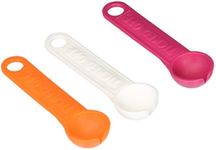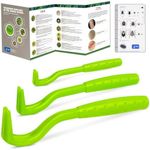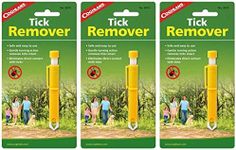Buying Guide for the Best Tick Removal Tools
Choosing the right tick removal tool is important for safely and effectively removing ticks from humans or pets. The goal is to remove the tick completely, without leaving parts behind or causing unnecessary discomfort. When shopping for a tick removal tool, you should consider how easy it is to use, how well it grips the tick, and whether it is suitable for the size of ticks you might encounter. Understanding the key features will help you select a tool that matches your needs and ensures safe tick removal.Type of ToolThe type of tick removal tool refers to its design and mechanism for removing ticks. Common types include tweezers, tick hooks, and tick cards. Tweezers are precise and can be used for small or hard-to-reach ticks, while tick hooks and cards are designed to slide under the tick and lift it out gently. If you expect to remove ticks from pets or in outdoor settings, a hook or card might be easier to use, while tweezers are often preferred for human use or for very small ticks. Consider who and what you’ll be using the tool on to decide which type is best for you.
MaterialThe material of the tick removal tool affects its durability, ease of cleaning, and safety. Tools are commonly made from stainless steel or plastic. Stainless steel tools are sturdy, reusable, and easy to sterilize, making them a good choice for repeated use. Plastic tools are lightweight and often disposable, which can be convenient for travel or single-use situations. If you want a long-lasting tool for home use, stainless steel is a good option, while plastic may be suitable for occasional or emergency use.
Size and GripSize and grip refer to how large the tool is and how easily you can hold and control it. Some tools are small and compact, making them easy to carry, while others have larger handles for a better grip. A tool with a comfortable, non-slip grip is important for precise removal, especially if you need to use it on a squirming pet or in outdoor conditions. If you have limited dexterity or plan to use the tool on animals, look for one with an ergonomic handle.
Ease of UseEase of use describes how simple and straightforward the tool is to operate. Some tools require a twisting motion, while others just need to be slid under the tick and lifted. If you are not experienced with tick removal, choose a tool with clear instructions and a simple design. Tools that are intuitive and require minimal steps are best for quick and stress-free removal, especially in urgent situations.
Cleaning and ReusabilityCleaning and reusability refer to how easily the tool can be sanitized and whether it is designed for multiple uses. Stainless steel tools can usually be boiled or disinfected, making them suitable for repeated use. Plastic tools may be harder to clean thoroughly and are often intended for single use. If you want a tool for ongoing use, make sure it can be easily cleaned and stored safely between uses.



















